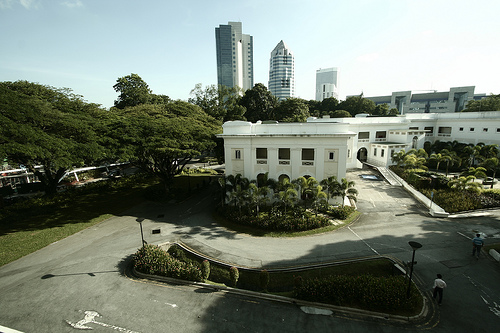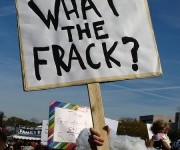Protesters concerned with the safety of fracking.Photo: ltmayersCross-posted from the Council on Foreign Relations.
The Natural Gas Subcommittee of the Secretary of Energy Advisory Board has published its 90-day interim report [PDF] on “Improving the Safety and Environmental Performance of Hydraulic Fracturing.” It is an exceptional piece of work. Anyone who wants to understand the environmental consequences of shale gas development, and the tools available to manage them, should read it in its entirety.
I won’t rehash the substantive contents of the report here; its executive summary, and various news reports, do a good job of that already. But I do want to flag an important observation about the political dynamics of shale gas development, from the body of the report, that may be missed:
The Subcommittee has been struck by the enormous difference in perception about the consequences of shale gas activities. Advocates state that fracturing has been performed safely without significant incident for over 60 years, although modern shale gas fracturing of two-mile-long laterals has only been done for something less than a decade. Opponents point to failures and accidents and other environmental impacts, but these incidents are typically unrelated to hydraulic fracturing per se and sometimes lack supporting data about the relationship of shale gas development to incidence and consequences. An industry response that hydraulic fracturing has been performed safely for decades rather than engaging the range of issues concerning the public will not succeed.
That’s right on the money. Alas, in what one can only hope is an attempt at self-parody, the American Petroleum Institute has responded to the report thusly: “DOE’s recommendations should be informed by an understanding, first, that shale-oil and gas development is already well regulated and safe, and, second, that it could create hundreds of thousands of new jobs, generate billions of dollars in additional revenue for our government and enhance our energy security.” Quite the logic: Development is already safe, therefore any study should be informed by the fact that development is already safe, and should come to the conclusion that it is already safe, which means that the study should recommend nothing. Some others from industry, to their credit, have been more circumspect in their responses.
Not to be outdone, more strident members of the environmental community have responded by largely ignoring the content of the report, which is pretty tough on industry, in favor of personal attacks on the subcommittee members. (As with industry, some other folks from the environmental world have responded more constructively.) An article in The New York Times, meanwhile, seems to take credit for prompting the creation of the subcommittee in the first place. That, I can quite confidently say, was not the case.
John Deutch, who chairs the subcommittee, summed up the report nicely in an interview with the Financial Times:
‘Our report is a compromise, and in that sense it will make nobody happy,’ Mr Deutch said. ‘This report is the only balanced discussion that I’ve seen of the shale gas industry.’
That’s true. If sensible people on all sides look past the fact that they don’t like everything in the report, they might even find the beginnings of a blueprint for compromise.



